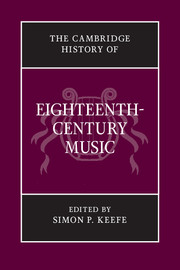Book contents
- Frontmatter
- PRELUDE
- PART I MUSIC FOR THE CHURCH
- INTERLUDE
- PART II MUSIC FOR THE THEATRE
- INTERLUDE
- PART III MUSIC FOR THE SALON AND CONCERT ROOM
- 16 Keyboard music from Couperin to early Beethoven
- 17 The serenata in the eighteenth century
- 18 Private music in public spheres: chamber cantata and song
- 19 Handel and English oratorio
- 20 The overture-suite, concerto grosso, ripieno concerto and Harmoniemusik in the eighteenth century
- 21 Concerto of the individual
- 22 Eighteenth-century symphonies: an unfinished dialogue
- 23 The string quartet
- POSTLUDE
- Appendix I Chronology
- Appendix II Institutions in major European cities
- Appendix III Personalia
- Index
- References
21 - Concerto of the individual
from PART III - MUSIC FOR THE SALON AND CONCERT ROOM
Published online by Cambridge University Press: 28 March 2011
- Frontmatter
- PRELUDE
- PART I MUSIC FOR THE CHURCH
- INTERLUDE
- PART II MUSIC FOR THE THEATRE
- INTERLUDE
- PART III MUSIC FOR THE SALON AND CONCERT ROOM
- 16 Keyboard music from Couperin to early Beethoven
- 17 The serenata in the eighteenth century
- 18 Private music in public spheres: chamber cantata and song
- 19 Handel and English oratorio
- 20 The overture-suite, concerto grosso, ripieno concerto and Harmoniemusik in the eighteenth century
- 21 Concerto of the individual
- 22 Eighteenth-century symphonies: an unfinished dialogue
- 23 The string quartet
- POSTLUDE
- Appendix I Chronology
- Appendix II Institutions in major European cities
- Appendix III Personalia
- Index
- References
Summary
The instrumental concerto, a vehicle for solo individualism within a rational framework, was essentially a child of the eighteenth century. The framework contained (yet simultaneously defined) this soloistic expression, a characteristically eighteenth-century tension between the individual and the corporate mass. As a genre, the concerto adapted to vast changes in musical style across the century, yet already in his earliest works Vivaldi captures the essence of the later symphonic concerto: the relationship between soloist and orchestra unfolding across a single span in a unique thematic and tonal argument. In short, the principle of discourse and interaction between these forces, played out in all its diverse richness up to Beethoven and beyond, was there from the very beginning.
Concerto grosso and aria
The early 1710s saw the publication of two monuments of Italian instrumental music. Corelli’s Op. 6 (1714) symbolized the culmination of the collaborative Roman ‘concerto grosso’, while Vivaldi’s Op. 3 (1711) introduced the thrilling new Venetian solo concerto, its individualistic display and cantabile melodies set in relief by the driving rhythms of vivid ritornelli. The clarity and order implicit in Vivaldi’s ritornello form – structural tuttis alternating with solos that together traverse an expressive trajectory – created for the first time an environment rich in potential for experiment with design on a large scale. In its musical vocabulary, too, the early Vivaldi concerto came to represent a defining instrumental genre, epitomizing the musical idiom of the 1710s (the ‘concerto style’ of the pioneering historian Manfred Bukofzer).
- Type
- Chapter
- Information
- The Cambridge History of Eighteenth-Century Music , pp. 583 - 612Publisher: Cambridge University PressPrint publication year: 2009
References
- 2
- Cited by



